Entreq Ground Boxes by Clement Perry
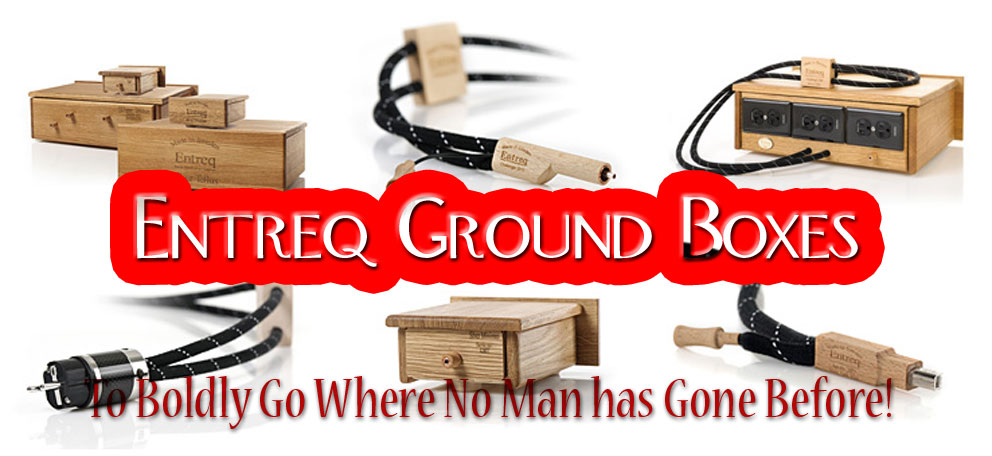

On My Soapbox

If you read my 2015 RMAF report, you know about the great fun I had walking the show with four good friends, Moreno Mitchell, Bill Jiggetts, John Bramble Sr. and his son John Bramble Jr. These chaps just happen to also use the Laufer Teknik Memory Player as their reference for digital playback. At dinner, we were all commenting on the remarkable qualities (and frustrations) of this Mark Porzilli-designed digital dynamo. This, of course, made its complete absence from the RMAF that much more disappointing. But my disappointment didn’t stop there. 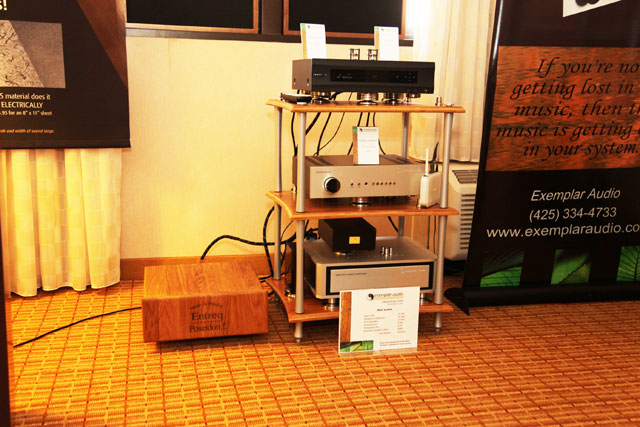
Walking into Paul Wakeen’s Stillpoints suite (above), I noticed the familiar Entreq Ground wood box on display. I’ve been reeling from this product’s powerful sonic impact on my system—a huge reduction of ground noise (a type of noise that I never knew existed prior the insertion of the Entreq). It surprised me that not a single room, outside of Stillpoints, was using it. The absence of these two extraordinary products left me second guessing what and who audio trade shows are really about: showcasing what’s new and hot and exciting, rather than products that can improve the performance of the gear you already own. It’s a sad state of affairs.
Off my Soapbox
I admit, I was never even remotely concerned about whether my system was properly grounded, until now. We have all experienced what mischief a loose ground wire on your turntable or FM tuner can cause, right? Years ago, ST contributor Dave Kaplan embedded a six-foot metal rod in his backyard and grounded his stereo. He was happy with the result and implored me to do likewise. I asked if I could hear for myself. A few days later I went over to his Brooklyn home and, for the life of me, I couldn’t detect a change. Nada.
Sunny Lo, designer of Sunny Majestic loudspeakers, has always emphasized the importance of an earth ground. In fact, Lo was among the first designers to employ a ground in his cables as well as a ground terminal on his loudspeakers. During their installation, Lo grounded his cables to my Majestic loudspeakers and performed A/B comparisons. As I expected, I could detect no difference (although perhaps, if I strained hard and closed my eyes, I thought I could detect a very slight drop in the noise-floor). Being unable to distinguish any of these purported differences, I maintained a skeptical attitude toward grounding. I bet you could imagine the amazed look on my face when I saw the $20,000 Tripoint Grounding box at CES a few years ago.
I already knew Per Olof Friberg, the designer for Entreq, but it was the introduction of his latest (and affordable) ground boxes, and his convincing explanation of what his products could potentially do to lower sources of distortion, that caught my attention. I shifted ground, so to speak, and requested a review sample.
Back in 2009 Dave Thomas and I got a first glimpse of this fledgling Swedish cable company. Their Konstantin series of cables were among the best designed cables we’d seen and they earned both our Editor’s and Publisher’s Choice Most Wanted Component for 2009 (a first of many awards and accolades that would accrue to the Entreq brand). The release of their Apollo series cables gave Friberg the proper footing to enter a less understood territory, but one that interested him greatly: complete system grounding.
Since the early ’80s, Friberg, an avid music lover and audiophile whose day job was in agriculture, had been deeply concerned with saving our planet from pollution. It was this desire that led him to the application of unalloyed metals, cotton and wood to audio products. After years of research and development, in 2009 he launched these natural products under the Entreq brand.
In 2010, the company officially launched the Tellus/Minimus Ground Box. Two years later, another Entreq product—the Silver Tellus—earned my Publisher’s Choice! award. Since that time, Friberg has introduced various Ground Boxes, AC conditioners, cables and accessories.
The natural earth minerals used to make the Entreq Ground Box are proprietary. Ken Ishiguro of Acoustic Revive comes to mind on the subject of using mineral mixtures in electrical components. Ishiguro keeps the specifics of his mixtures close to his vest too. Ishiguro’s products, I can attest, work as advertised and are among the best of their kind. Of the weird and puzzling devices Ishiguro has created, his small, circular RGC-24 ground conditioner is particularly impressive. An affordable ($600) ground conditioning product that offers clear, though minor, positive results — at last!
One can only speculate as to how Friberg (or Ishiguro) discovered that these minerals would favorably impact a stereo system. Entreqs various models employ different quantities and blends of specialized minerals. The large Silver Tellus ($2,699), for example, uses 30% more silver than the standard Tellus ($1,149). It is also larger, heavier and has four ground terminals versus three for the standard model. Friberg designed the much smaller (and easier to conceal) Silver Minimus ($729), and standard Minimus ($399) for preamps, CD transports, DACs and music servers. 
Friberg shipped me a Silver Tellus and two Silver Minimus ground boxes back in the summer of 2013 (photo above). At that time Per Olof forgot to include his Eartha Cables that usually accompany his ground boxes (they are sold separately and start at $99.00). Without being aware that anything was missing, since there was no mention of Eartha cables on the Entreq website at that time, I used inexpensive 12 gauge wire purchased at the local Home Depot. I wired the Silver Tellus to the Sunny Majestic ground terminals and the Silver Minimus to both the Laufer Teknik Memory Player and to my Behold preamp. Having no information about burn-in time or what to expect, I just started listening to music and, not surprisingly, heard no difference at all. This of course reminded me of my previous experience with grounding devices. Giving the Entreq devices the benefit of my doubt (and because they didn’t seem to harm the sound) I left them in place.
Looking over my system one evening some 12 months later, I noticed the Silver Tellus behind my humongous Sunny loudspeakers, realized I’d forgotten them, and wondered if perhaps they were now having any effect on the sound. To find out, I listened intensely for about thirty minutes, then removed the grounding wires, and listened to the same series of songs once again. I found that the music sounded thinner, less dimensional and with a loss in weight. However, I was surprised to find that reconnecting the grounding wires didn’t restore these improvements!
Puzzled, I Googled Entreq and saw a few forum posts discussing the amount of time it takes for the Silver Tellus to burn-in. Three-days was the norm. Okay, that explains why I hadn’t heard any difference after initial installation. I also found note that if you disconnect the grounds it will take days before the sound returns to normal.
So I let the Silver Tellus resettle in for the next couple of days, listening on and off for the harmonic weight, depth and naturalness to return. I also called Per Olof Friberg, mentioning my impressions and apologizing for forgetting about the presence of the Silver Tellus in the system. He understood and even remarked at how difficult it must be auditioning a device so new and out of the ordinary. He apologized for not providing an owner’s manual detailing the suggested ways the ground boxes can be connected and positioned.
After three days, I went back to serious listening. For the life of me, I couldn’t detect any of the expected differences. But a subliminal sense seemed to tell me that something about the sound wasn’t just different, but better. The sound was a tad richer, less grainy and more dimensional. The strongest impression was how natural (less electronic) the overall presentation sounded. Ultimately, trusting my ears and experience, I ended up simply getting lost into the music. After this lengthy and enjoyable session, I concluded that, indeed, the system is quieter, more harmonically rich and more realistic sounding. 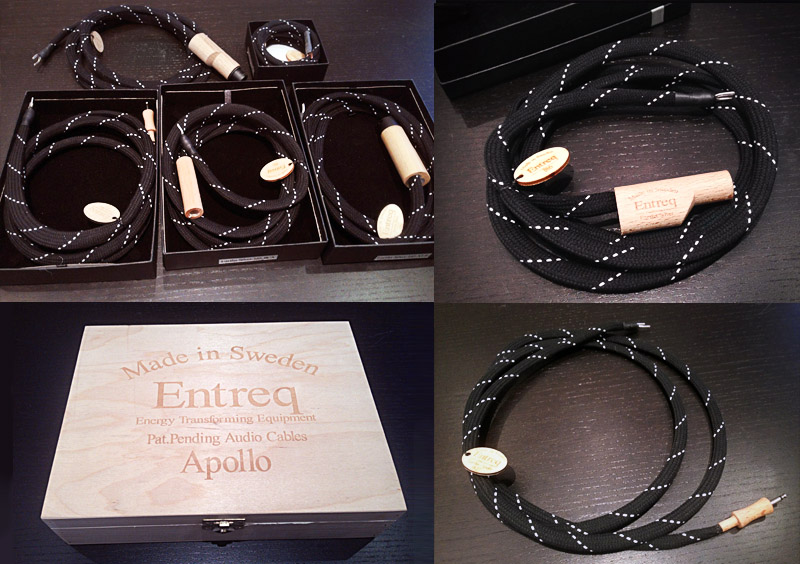
Days later, a surprise FedEx shipment from Entreq arrived at my doorstep. Inside, were two Eartha Challenger cables ($379) constructed of a silver/copper blend, two Eartha Silver RCA cables ($439) said to provide a warmer, burnished sonic signature, and one Eartha Apollo ($749) RG45 Ethernet cable said to be extremely neutral and open sounding. Also included were two of Entreq’s latest products introduced this summer: the Silver Cleanus and Olympus Minimus ($2,429). Eartha series cables come at different price points, ranging from the Copper starting at $99 to the Atlantis at $1,639, their most expensive. Friberg emphasized that the Atlantis may not be as well suited to a given system as a lesser model. It is a matter of equipment, configuration and personal taste.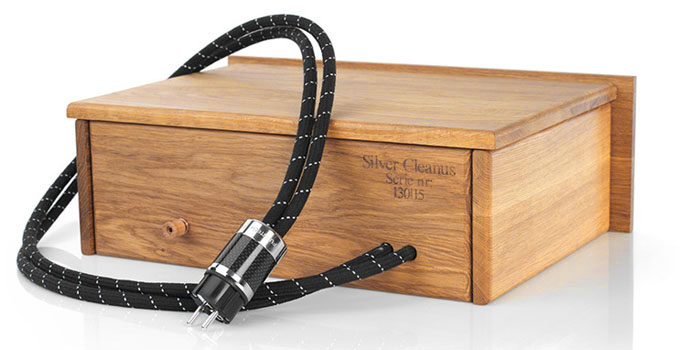
The Silver Cleanus ($3,150) was designed as a passive AC conditioner and is optimized to work alongside the Silver Tellus to dramatically lower high-frequency noise and distortion without any reduction in dynamics or musicality. The Olympus Minimus, also released in the summer of 2015, is the culmination of everything Per Olof learned while designing his other devices. Formed of entirely new minerals that include Magnesium and Silver, the Minimus is said to be the best of the mini-ground boxes available. They are designed to ground a single front-end device.
Each ground box can be hooked up either as a source ground or chassis ground. I had never used them as anything but in chassis ground mode. (Attempting to use a single ground box as both a source ground and chassis ground is not recommended.) But with the arrival of the Apollo RG45 cable I had the opportunity to connect the Olympus Minimus as a source ground to my Memory Player’s Ethernet input.
The Silver Tellus comes equipped with four high-grade copper ground terminals and I was using only two for the Sunny Majestic loudspeakers. Having two unused terminals, I discovered that I could combine these terminals into one using a jumper wire. After doing this, I connected the Silver Cleanus directly to the Silver Tellus. The Silver Cleanus comes equipped with an male IEC and includes a five foot AC cable. Friberg states that it can work either in passive or active mode and thus plugging it in is optional. I threw caution at the wind and plugged it in to an AC receptacle. I didn’t want to wait an additional 72 hours for these boxes to settle in. I wanted to hear something different right away!
Sound
 With all these ground boxes working together the sound, not surprisingly, immediately changed for the better. The overall quietness I’ve always admired in Behold electronics became even more obvious. Voices and piano in particular had a cleanliness to them as if the music had been switched to hi-rez, upsampled and/or remastered. This without the dampness and loss of high frequency extension usually associated with this degree of noise reduction. Sarah Vaughn’s 1974 Pablo recording of Send in the Clowns (featuring Count Basie and his orchestra) has always been among my favorites. On this recording, Sarah gets the chance to demonstrate her style and versatility more than usual because by 1974 her chain-smoking had done major damage to her multi-vocal range. Still strong and powerful though, her voice hit me right in the heart. Knowing this recording so well, I found the increased ease, delicate flow and the added harmonic weight of Sarah’s huskier voice demonstrably more lifelike in timbre and dynamics.
With all these ground boxes working together the sound, not surprisingly, immediately changed for the better. The overall quietness I’ve always admired in Behold electronics became even more obvious. Voices and piano in particular had a cleanliness to them as if the music had been switched to hi-rez, upsampled and/or remastered. This without the dampness and loss of high frequency extension usually associated with this degree of noise reduction. Sarah Vaughn’s 1974 Pablo recording of Send in the Clowns (featuring Count Basie and his orchestra) has always been among my favorites. On this recording, Sarah gets the chance to demonstrate her style and versatility more than usual because by 1974 her chain-smoking had done major damage to her multi-vocal range. Still strong and powerful though, her voice hit me right in the heart. Knowing this recording so well, I found the increased ease, delicate flow and the added harmonic weight of Sarah’s huskier voice demonstrably more lifelike in timbre and dynamics.
 Switching it up just a tad, I grabbed Frank Sinatra and Duke Ellington’s 1968 release of Sunny, from the album “Francis A and Edward K.” This is another legendary big-band recording that delights everyone that hears it. What proved most impressive was the wonderfully raw and realistic “blat” of the brass section alongside Sinatra’s easy, almost nonchalant vocal phrasings. I love the way Sinatra is mic’d, appearing to be surrounded by Ellington’s band, yet is never drowned out and is always the focus of attention. With the Entreq in the system, this entire disc became both easier on the ears and much more soulful. The lowering of noise allows for even greater volume without the issues usually associated with playing loud. In fact, I would say the sound overall is silkier, less congested, more colorful while more resolving.
Switching it up just a tad, I grabbed Frank Sinatra and Duke Ellington’s 1968 release of Sunny, from the album “Francis A and Edward K.” This is another legendary big-band recording that delights everyone that hears it. What proved most impressive was the wonderfully raw and realistic “blat” of the brass section alongside Sinatra’s easy, almost nonchalant vocal phrasings. I love the way Sinatra is mic’d, appearing to be surrounded by Ellington’s band, yet is never drowned out and is always the focus of attention. With the Entreq in the system, this entire disc became both easier on the ears and much more soulful. The lowering of noise allows for even greater volume without the issues usually associated with playing loud. In fact, I would say the sound overall is silkier, less congested, more colorful while more resolving.
I could hear the obvious sonic advantage, in my particular system, of using a source ground connection as opposed to a chassis ground connection. If one were to ask me, I personally found the Entreq boxes to become increasingly more impactful and thus effective in the source ground mode.
Audiophiles spell patience… N.O.W.
I decided to give some of the guys a call and talk about the Entreq ground boxes. My good friend and ST contributor Moreno Mitchell was also experimenting with a couple of different model Entreq ground boxes that had just arrived at his home. He commented that the Memory Player Ethernet connection is solid and has very low noise. But a better connection, Moreno presumed, is via the USB input. So, I took Moreno up on his suggestion (although he hadn’t tried it himself), unplugged the Apollo 45 Ethernet cable from the MP via the Olympus Minimus and plugged it directly into my Behold APU768 preamplifier’s Ethernet input.
This changes I heard were instantaneous and major which came as something of a shock – considering that it normally took days to determine any changes when previously disconnecting these ground boxes. I kid you not, this was the sonic equivalent of what usually accompanies a major equipment change, not moving a wire from one source to another. The sonic landscape, especially the bass, became much cleaner, clearer, more taut and liquid sounding. The ability to hear the different notes that made up low-end separate and apart from the mid-bass was ear and eye-opening. The longer I listened the more convinced I became that it was really happening and not some temporary impression brought on because a change was made (which does happen more than we want to admit). Again, patience and experimentation were the real winners here. If were not for that, I would have had a hard time convincing myself that the Entreq ground boxes were a must have. Yes, I would be the first to admit that they worked, but nothing could have prepared me for this level of improvement. On the sheer luck of merely switching a cable between two sources, the Entreq went from moderately impressive to OH MY FRIGGIN GOD! In the case of the Entreq boxes and experimentation between sources, patience proved most certainly a virtue.
The more music I played, the more I realized how absolutely vital the Entreq ground box is to my preamp’s Ethernet input. The ability to gradually hear not just more deeply into the music, but through its manifold layers of meaning, subtleties and nuances, reminded me of how long the road to reducing noise actually is. That a Swedish farmer could develop a device that allows you to hear further into the original intentions of the musicians has been an unbelievable experience.
If you’re like me, you’ve probably guessed that many of your less-than-stellar recordings were the result of the microphones, engineering, studio ambience or the electronics of the era. But, NEVER your equipment. However, when you hear Sarah and Basie, Sinatra and Ellington so fully fleshed out and wholesomely realistic, you too will be shocked at who the real culprit is: the noise that lives in and through our beloved electronics.
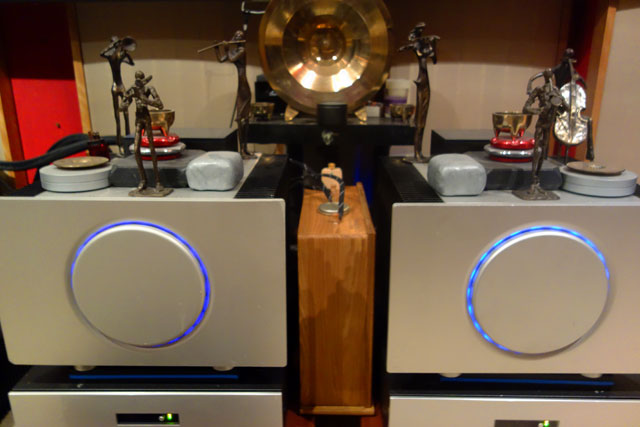
In summary
The idea that boxes literally tied by a single wire could improve the authenticity and realism, not to mention dynamic expression, to levels I could never have imagined is simply extraordinary. Patience and experimentation is highly recommended since finding the “right spot” is going to take some time and effort. However, I think the sonic payoff is more than worth the price. The Entreq ground boxes are not cheap and a multi-tier system can add up rather quickly. However, you can start off at your front end with a single Silver Minimus which retails for with a Eartha cable for less than a grand. A 30-day money back audition the TweekGeek offers is recommended no brainer. After installing the Entreq ground boxes I, unwittingly discovered that my system was clearly contaminated by noise and distortion that had gone totally unnoticed. You know how the story goes: I never knew anything was there until it was removed! I’ve spent a lot of time, money and effort attempting to address various noises and suddenly came to the realization that isolating platforms, acoustic enhancement devices, great cabling and AC conditioning can only go but so far. It was in that regard that I ordered more Entreq ground boxes and discovered that grounding my Behold amplifiers via the company’s newest Poseiden ground box (above photo) has provided sonic advantages that I am still trying to wrap my head around.
I hope you too can audition the improved sonic experience of Entreq ground boxes. I believe they’ve allowed me to “finally go where no man has gone before.” My Publisher’s Choice Award for 2015.

clement perry
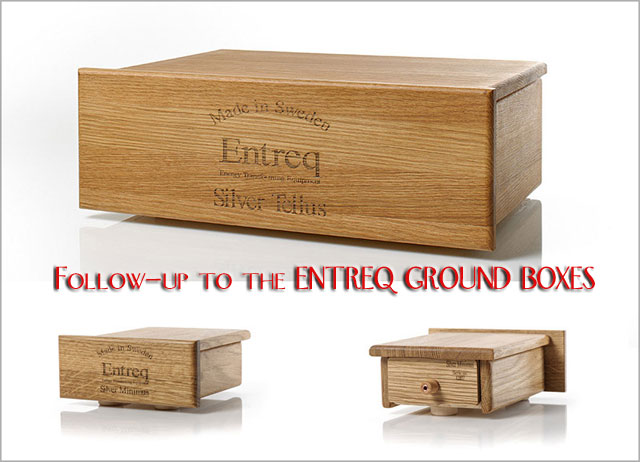
New Sonic Heights
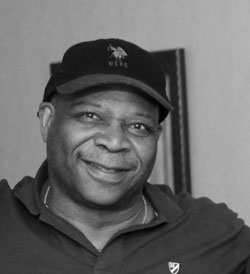 My first encounter with the Entreq company goes a few years back to when I read a review by senior editor Dave Thomas right here on Stereo Times. He wrote fondly of his experience with the Entreq Konstantin cables and I never forgot how much he and Clement both admired this new Swedish-based hi-end audio manufacturer. This must have been around 2009 because like Clement, I too use the Sunny horn loudspeakers. Thanks to Clement, I was offered the rare opportunity to have my Sunny 3W12 loudspeakers’ jumper cables upgraded with a special harness of the Entreq Konstantin cable employing Speakon connectors.
My first encounter with the Entreq company goes a few years back to when I read a review by senior editor Dave Thomas right here on Stereo Times. He wrote fondly of his experience with the Entreq Konstantin cables and I never forgot how much he and Clement both admired this new Swedish-based hi-end audio manufacturer. This must have been around 2009 because like Clement, I too use the Sunny horn loudspeakers. Thanks to Clement, I was offered the rare opportunity to have my Sunny 3W12 loudspeakers’ jumper cables upgraded with a special harness of the Entreq Konstantin cable employing Speakon connectors.
How serious Entreq is, as a top-tier cable manufacturer stared me dead in the face through this one-time encounter. The improved overall balance, harmonic integrity and utter soulfulness of my system improved greatly. I became an instant fan of Entreq cables. Fast forward to 2014, after numerous encounters and long term experiences with various AC conditioners, room enhancers and plethora of tweaks, nearly leading into the installation of grounding rods installed into my backyard. That was, until I found out about Per Olof Friberg’s latest grounding products. Like Clement mentioned, I too had pretty much become content to live on with the Acoustic Revive RGC-24 ground boxes from Japan. They did as advertised in cleaning up a good portion of low-level noise and high-frequency grunge.
I did find other notable claims at reducing noise through grounding schemes like the Tripoint ground box (one look at its asking price made me seek elsewhere). I started hearing some buzz from both Clement and Buffer Ergmann of Laufer Teknik about the Entreq ground boxes and their overall effectiveness. It was no coincidence to find that Paul Wakeen, president of Stillpoints USA, a product I highly endorse, is also the US importer of Entreq too! After a short discussion with Wakeen, I immediately ordered a Silver Tellus with my 30-day money back guarantee intact. Some days later, when the package finally arrived via UPS, I noticed for the first time how heaving this unit was. Well packed in a wooden crate with Entreq stamped on its sides, I noticed I also needed a special drill bit to remove it from its box. As much as it pained me to find the right bit for my drill, I admired the packaging and at once, my respect had gone up even further.
My initial experience with the Silver Tellus was as Clement described in his review almost to the letter – except mine came with a pair of Entreq Apollo XLR and RCA cables – and I already knew to go source ground as opposed tochassis ground. I connected the system as a source ground directly to my Behold APU769 preamplifier and Laufer Teknik Memory Player outputs. And just like Clement, I came away somewhat disappointed. I forgot it took about 72 hours for Entreq ground boxes to actually impact the component their plugged into.
Speaking with Paul Wakeen via cell phone, he reassured me that the units have to mate with whatever you connect them to. He reiterated the minimum 72 hours before any serious listening is recommended. The one thing Wakeen stressed the most was patience.
My initial impressions were okay, but nothing like what I expected. However, after one full week of listening and never really noticing anything that caught my attention or stood out, I decided to just remove the Eartha Apollo cables from my front-end.
Okay, what just happened?
Upon removing the Eartha Apollo cables, I too noticed – in a similar fashion to what Clement also experienced – the sound took a turn for the worse. The grunge returned. Grunge, I admit that I never knew was there in the first place had returned. The sense of bloom, naturalness and depth had lessened while the overall listening experience was noticeably reduced. I immediately reattached the Eartha Apollo cables and hit the play button. Fortunately, the sound became at once more natural, cleaner and regained greater dimension. I guess, I didn’t totally lose the charge these ground boxes needed. However, with each passing day, the sound improved ever-so noticeably by way of greater dynamics, richer tonality and a blacker background.
Since the addition of the Entreq ground boxes, and AC power distribution management system, my system sounds less electrically stimulated and closer to the real thing. Finally, I am hearing more into the music and less into the distractions and distortions I somehow thought was always in the music. The bass is deeper, the mid-range is more rounded and holographic. High frequencies possess more detail yet sound smoother and richer with less artifact.
Without the Entreq ground conditioners in my system I would still have an awesome sounding system. Knowing what I now know, life without the Entreq would be far more damped-down and constricted sounding. Life with the Entreq is a beautiful place. My listening space is imbued with far more realism, finesse and me; a more purposeful attitude for my music. I am hearing new music in my old collection and can now sit and go through dozens of songs with no fatigue. The Entreq ground conditioners are the real deal because they remind me of music and less about components. Isn’t that what this hobby is supposed to be all about?


Moreno Mitchell
*Above Entreq photos courtesy of Lotus HiFi*
Entreq Specifications:
Silver Minimus : $729.00
Silver Tellus: $2,699.00
Olympus Minimus: $2,429.00
Silver Cleanus: $3,150.00
Website: www.entreq.com/
USA Distributor: Stillpoints USA
Website: www.stillpoints.us
One thought on "Entreq Ground Boxes by Clement Perry"
Leave a Reply
Stereo Times Masthead
Publisher/Founder
Clement Perry
Editor
Dave Thomas
Senior Editors
Frank Alles, Mike Girardi, Russell Lichter, Terry London, Moreno Mitchell, Paul Szabady, Bill Wells, Mike Wright, and Stephen Yan,
Current Contributors
David Abramson, Tim Barrall, Dave Allison, Ron Cook, Lewis Dardick, John Hoffman, Dan Secula, Don Shaulis, Greg Simmons, Eric Teh, Greg Voth, Richard Willie, Ed Van Winkle, Rob Dockery, Richard Doran, and Daveed Turek
Site Management Clement Perry
Ad Designer: Martin Perry





The article sheds light on the often overlooked aspect of grounding in audio systems. The Entreq Ground Box and similar products have the potential to reduce ground noise and improve audio system performance. It raises an interesting perspective on the focus of audio trade shows, emphasizing innovation over products that enhance existing gear.